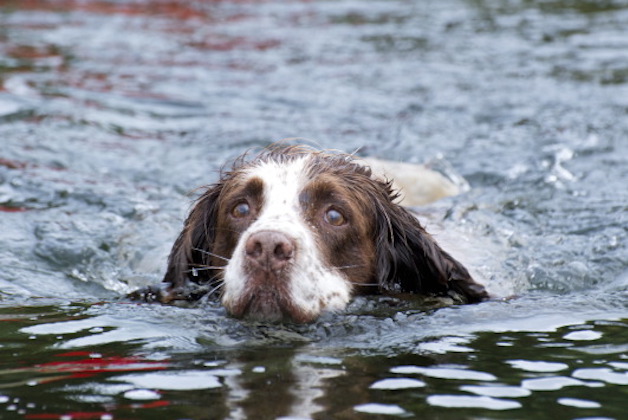Win CENS ProFlex DX5 earplugs worth £1,149 – enter here
Why working dogs retire and when it’s likely to happen
 Black Labrador
Black Labrador
When working dogs retire
One of the saddest sights on a shoot is seeing an old dog wandering around with a bird in its mouth, unsure of what it is doing. It’s poignant if, just a couple of seasons ago, this particular dog was one of the stars of the shoot, the member of the picking-up team that could always be depended on to find the bird that had defeated other dogs.
It was seeing dogs like this that inspired John Houlton to launch an investigation into why and when working dogs retire. John is best known as one of our leading experts on hip dysplasia, but he has long had a specialist interest in working gundogs and runs a picking-up team of labradors.
Breed sample
The research on why working dogs retire, based on a sample of 665 dogs, makes fascinating reading. If you include cross-breeds such as sprockers, some 22 breeds feature, with labradors in the majority (354), followed by springers (123) and cockers (82). Some 429 dogs (65%) were predominately picking-up dogs, with 143 (22%) beating dogs. Only 27 (4%) were peg dogs, and while nine dogs in the survey were trialling dogs, a mere six individuals (0.9%) were used chiefly for wildfowling.
The relatively small number of peg dogs may reflect the fact that their owners are probably more interested in shooting than dogs, so are less likely to take part in such research.
The paper includes a number of graphs, all understandable, even for those of us unpractised at looking at such things. One of the graphs shows the number of days these dogs worked: only 5% did 10 days or fewer a season, while the majority (just over 40%) did between 11 and 30 days, followed by a further 30% on 30 to 50 days. A significant proportion (nearly 8%) did an impressive 71-plus days.
How long do working dogs work for?
Most interesting of all is the number of years the dogs worked.
This took into account those that died at a young age, or those that picked up injuries that stopped them from going out, so a mere 2% of dogs managed just a year, while the majority completed eight, nine or 10 years. (Read this piece on semi-retired gundogs.)
After 10 years, there’s a sharp drop, with fewer than 10% managing an 11th season, while only 1% completed 14 years (remember that a dog that performs for 14 seasons is likely to be at least 15). Not surprisingly, none did 15 seasons. Unfortunately, there are no statistics for whether the hardest-working dogs (those that did 70 days a season) retired earlier than those with less demanding lives.

Most springers stopped work at 11
Reasons working dogs retire
I was intrigued by the reasons for dogs retiring. Lameness was responsible for 36% of retirements, closely followed by old age (34%). Eight of the 10 dogs that retired due to fractures had elbow breaks, while the remaining two had carpal fractures. Most of us depend on a whistle to communicate with our dog, so when the dog can’t hear the whistle any more it’s generally time for retirement. Thus you won’t be surprised to learn that 52 dogs retired due to deafness, with rather more springers bowing out for this reason than labradors or cockers. (Read more about deafness in working dogs.)
One would have thought that peg dogs were more likely to be afflicted with deafness than those picking-up or in the beating line, but this didn’t prove to be the case. Arthritis and cancer were the two main causes for dogs ending their working lives. Some 113 dogs suffered from arthritis — as a fellow sufferer, I sympathise. The highest incidence of arthritis was found in labradors, with the lowest in cockers.
Cancers
We all know cancer is a major killer of dogs, and this survey found 62 labradors were diagnosed with cancer, compared with 16 springers and eight cockers. Six of the flatcoats also suffered from the disease, out of a total of 28 surveyed, which is rather fewer than I would have expected.
In labs, the most common cancers were bone, spleen, lymphoma and mammary, but there were also incidents of many other types. Some 92 dogs in the survey were put down due to cancer, a significant percentage of those taking part.
One of the most interesting tables is that listing the reasons for retirement for the 463 dogs that reached that stage. Four dogs became gun-shy, two kept getting lost and another two started eating game. Seven lost the ability to work a full day, and eight gave up due to blindness, but only one retired due to dementia. As dementia is a serious concern in pet dogs, I wonder whether the active life of a shooting dog helps stave off this condition? I was amused that eight dogs retired to “lead a life of luxury”.

Some dogs retire to live a life of luxury
Arguably the most interesting result of the survey was that most springers stopped work at 11, the same age as golden retrievers; for labradors, retirement is typically at 10; and for cockers, it’s nine. Significantly, no work-related issues were identified and gundogs appear to have similar causes of mortality to the general canine population.
Related Articles
Get the latest news delivered direct to your door
Subscribe to Shooting Times & Country
Discover the ultimate companion for field sports enthusiasts with Shooting Times & Country Magazine, the UK’s leading weekly publication that has been at the forefront of shooting culture since 1882. Subscribers gain access to expert tips, comprehensive gear reviews, seasonal advice and a vibrant community of like-minded shooters.
Save on shop price when you subscribe with weekly issues featuring in-depth articles on gundog training, exclusive member offers and access to the digital back issue library. A Shooting Times & Country subscription is more than a magazine, don’t just read about the countryside; immerse yourself in its most authoritative and engaging publication.







